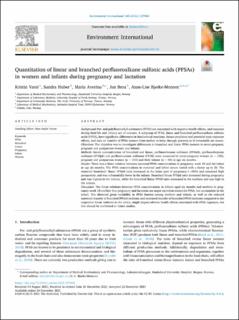| dc.contributor.author | Varsi, Kristin | |
| dc.contributor.author | Huber, Sandra | |
| dc.contributor.author | Averina, Maria | |
| dc.contributor.author | Brox, Jan | |
| dc.contributor.author | Monsen, Anne-Lise Bjørke | |
| dc.date.accessioned | 2023-01-12T14:51:33Z | |
| dc.date.available | 2023-01-12T14:51:33Z | |
| dc.date.created | 2022-02-11T14:55:37Z | |
| dc.date.issued | 2021 | |
| dc.identifier.citation | Environment International. 2021, 160. | en_US |
| dc.identifier.issn | 0160-4120 | |
| dc.identifier.uri | https://hdl.handle.net/11250/3043157 | |
| dc.description.abstract | Background - Per- and polyfluoroalkyl substances (PFAS) are associated with negative health effects, and exposure during fetal life and infancy are of concern. A subgroup of PFAS, linear and branched perfluoroalkane sulfonic acids (PFSA), have significant differences in biochemical reactions, bioaccumulation and potential toxic exposure effects, and data on transfer of PFSA isomers from mother to baby through placenta or in breastmilk are scarce.
Objectives - The objective was to investigate differences in branched and linear PFSA isomers in never-pregnant, pregnant and postpartum women and infants.
Methods - Serum concentrations of branched and linear, perfluorohexane sulfonate (PFHxS), perfluoroheptane sulfonate (PFHpS) and perfluorooctane sulfonate (PFOS) were measured in never-pregnant women (n = 158), pregnant and postpartum women (n = 114) and their infants (n = 94) at age six months.
Results - There was a linear relation between maternal PFSA concentrations in pregnancy week 18 and the infant at age six months. The PFSA concentrations in maternal and infant serum varied with a factor up to 20. The maternal branched/ linear PFHxS ratio increased in the latter part of pregnancy (+45%) and remained high postpartum, and was substantially lower in the infants. Branched/linear PFHpS ratio increased during pregnancy and was highest in the infants, while the branched/linear PFOS ratio decreased in the mothers and was high in the infants.
Discussion - The linear relations between PFSA concentrations in infants aged six months and mothers in pregnancy week 18 confirm that pregnancy and lactation are major excretion routes for PFSA, but accumulate in the infant. The observed great variability in PFSA burden among mothers and infants, as well as the reduced maternal transfer of branched PFHxS isoforms and increased transfer of branched PFOS isoforms compared to the respective linear isoforms to the infant, might impact adverse health effects associated with PFSA exposure, but this should be confirmed in future studies. | en_US |
| dc.language.iso | eng | en_US |
| dc.publisher | Elsevier | en_US |
| dc.relation.uri | https://reader.elsevier.com/reader/sd/pii/S0160412021006905?token=F209911F9A7E8A58A0792AF031CBE0286C72AB1320E548133A88ABF35ABD905173AA9A9E8E1E774D7B1759FD9F6BE4DC&originRegion=eu-west-1&originCreation | |
| dc.rights | Navngivelse 4.0 Internasjonal | * |
| dc.rights.uri | http://creativecommons.org/licenses/by/4.0/deed.no | * |
| dc.title | Quantitation of linear and branched perfluoroalkane sulfonic acids (PFSAs) in women and infants during pregnancy and lactation | en_US |
| dc.type | Peer reviewed | en_US |
| dc.type | Journal article | en_US |
| dc.description.version | publishedVersion | en_US |
| dc.source.pagenumber | 10 | en_US |
| dc.source.volume | 160 | en_US |
| dc.source.journal | Environment International | en_US |
| dc.identifier.doi | 10.1016/j.envint.2021.107065 | |
| dc.identifier.cristin | 2000599 | |
| cristin.ispublished | true | |
| cristin.fulltext | original | |
| cristin.qualitycode | 1 | |

